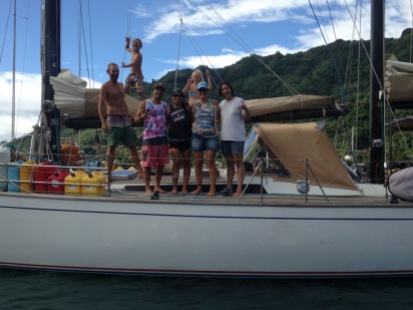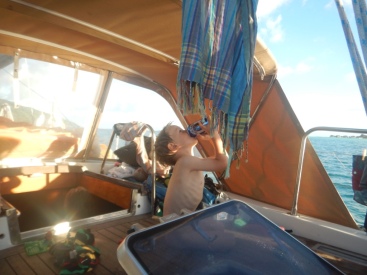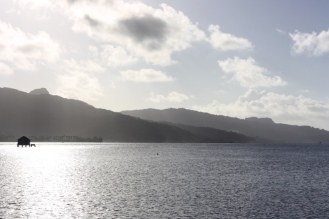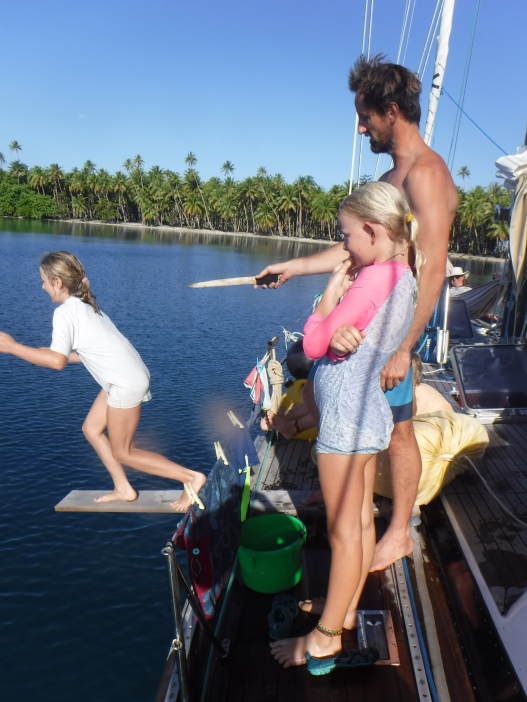Our time in the Society Islands of French Polynesia has a soundtrack. There are the drums, incredible drums. There are the beautiful haunting songs of the locals and the cheerful accompaniment of the ukulele. And then of course there is Moana. Make way, make way…
And yes indeed, we needed to make way for the Societies. As the best known of the French Polynesian Islands we weren’t expecting very much. Places like Tahiti and Bora Bora held preconceived ideas and images but we had to leave those behind and reassess everything we thought we already knew. And yes despite our best efforts we became the cliche and fell for the Society Islands hook, line and sinker!
The stereotypes are true but in the best way. Polynesians are big beautiful friendly people. They are covered in fabulous tattoos and they actually do wear crowns of beautiful fresh flowers to almost every occasion – even a trip to the supermarket it would seem. We were lucky, we arrived during the month of Heiva – a cultural celebration of music, dancing and sport celebrated across the islands – performed more for the local population than the tourists. Colourful costumes, beautiful song, loud drums, fragrant flowers, proud tradition, big smiles, incredible dancing and amazing bodies were all on display!
Everyone has an image of Tahiti and I’m sure much of what you imagine is probably true but for us the Tahiti dream was a big supermarket and an array of boat chandleries. We needed to get some stuff done! We anchored among the hordes off Marina Taina and literally ran to the nearby giant French Carrefour supermarket – even the kids couldn’t wait! We hadn’t had a good supermarket in almost 6 months and so we wondered the air-conditioned isles in a semi-catatonic state amazed at the choice on offer! We emerged much poorer (French Polynesia is expensive!) but delighted to have proper cheese, meat, fresh vegetables and salad back on the menu. It was great to be able to push our overladen trolley down the road all the way back to the dinghy dock. Tahiti was also about our check list – ticking off boat jobs and stocking up on boat bits for the next 6 months until New Zealand. We finally found good internet, sitting on the concrete floor of the town hall which was essentially an open pavilion, about 10 minutes walk from the marina. We unfortunately ran out of time for too much exploring of the island but Tahiti’s capital Papeete was fun – good shops, great market, interesting museums and fun food trucks called Roulettes down on the waterfront.
Warning: Mom and Dad don’t read this bit. In Tahiti I also got the ultimate Polynesian souvenir in the form of a tattoo. The Polynesian patterns all mean something and are symbolic – in pre-European times, tattoos acted as a map to a person’s social status and achievements. The Marquesas are known for perfecting the art and I had wanted one ever since I had seen the beautiful intricate geometric patterns there – they really are the most stunning works of art but I was determined to find someone with whom I could communicate. It’s vital to find someone you trust as the tattoo artists in this part of the world loosely interpret your ideas/thoughts/personality/history into their own unique artwork. I had been recommended a good studio in Papeete so I grabbed my French speaking friend, Emily, for support and braved the scary entrance (motorbikes, mirrored front, intimidating signage, heavy metal music!) and HUGE Polynesian guys inside to talk through my ideas and make an appointment. When I showed up for my slot a week later I was reassured to see that my mo-hawked tattooist had made a very delicate, detailed and beautiful sketch of my ideas – it was perfect, full of symbolism and meaning. I knew I was in good hands.
Enticed by the promise of cocktail parties, traditional sports and Tahitian dancing, we decided to join in with the Tahiti to Moorea Sailing Rendezvous – a weekend cruising and information gathering rally. We also thought we may meet some new boats. We didn’t really meet anyone new but we did have a great weekend. Starting on Friday night with flower leis, wonderful dancing and yummy cocktails. We then joined the fleet for the ‘race’ across the Bay to neighbouring island, Moorea. We had the pleasure of three young Tahitians onboard Blue Zulu; Tahia, Heimanu and Mahana, who signed up to experience sailing for the day. It was a complete treat to have them onboard – they generously bought all their favourite local foods for us to try, helped us fish, helped us sail and ultimately helped us win our class – Blue Zulu was the first monohull across the line! It may have been because most of the other boats gave up and motored due to the very light winds but still persistence pays and it was a very special moment to cross the finish line with Heimanu doing a traditional haka and singing along loudly to the Moana soundtrack while Fin blew with all his might on the sails!
The rest of the weekend was also great fun with plenty of traditional food, dancing and games. We all got to have a race in the six-person outrigger canoes known as Va’a. Much to our amazement, our team Bonzulu (made up of P and I and our friends Emily and Tom from SY Bonaire) won both our heats to make it into the finals. We unfortunately weren’t victorious but rather proud of ourselves none-the-less! The kids joined in the bamboo and banana carrying races, coconut husking, traditional dancing lessons and spent a large amount of time in the hotel pool. We in the meantime learnt all about weather systems, cruising advice for Tonga and Fiji and plenty about potential marinas in New Zealand – a good weekend all round!
Our time in the Society Islands was made even better by having some very special people onboard. The wonderful Waller family from Cape Town braved over two days of travelling to reach the other side of the world – then they managed something even more remarkable – a month onboard Blue Zulu. Eight people in a 50ft x 13ft space is not for the faint hearted but we thankfully lucked out and all got along brilliantly. It was a real treat to have this enthusiastic, warm, energetic and generous family with us. It’s difficult to capture, convey and perhaps understand our current life, our odd adventures and even just our general day to day living so it is special to share it with people – thank you Mike, Liz, Joy and Jack for visiting us.
The Wallers it turns out are natural cruisers and so were happy participants in all aspects of life onboard and together we explored almost every inch of these beautiful islands. Moorea offered us majestic mountains, lush landscape, incredible hikes and amazingly tame sea life – stingrays and black tip sharks joined Jack (age 4) for his first ever snorkel! We hiked through the beautiful Opunohu Valley to the lookout at Belvedere. In the pre-European era, the Opunohu Valley was densely populated and dotted with marae (traditional temples) as well as dwellings, archery platforms and other structures, some of which have been restored and maintained. It’s believed the valley was continuously inhabited for six centuries, and the oldest surviving structures date from the 13th century. It was both eiree and awesome to explore the ruins, the stunning valley and learn more about the history of the area.
Then it was a bumpy overnight motorsail to Huahine. Laid-back Huahine, turned out to be everyone’s favourite – we enjoyed the relaxed ramshackle capital Fare and we loved the beautiful turquoise south lagoon, Avea, in Huahine Iti – which was a good thing as we got a bit stuck there due to high winds. We had a wonderful traditional Polynesian lunch at Chez Tara, Mike and P windsurfed, the kids sailed Bonaire’s Tera, we snorkelled, read books and went for walks. It was a lovely relaxed time in a gorgeous anchorage.
We also anchored off Hana Iti beach where we had a bbq with our friends off SY Bonaire and SY Anila to celebrate two years living onboard Blue Zulu. It was a warm, fun, beautiful night which echoed much of our feelings about the last two years onboard. The next day we met Philip, the fabulous local beach caretaker, who invited us to join him making some coconut bread. Little did we know that this innocent sounding activity would take all morning as we had to collect, then husk and grate the fresh coconut. We then had to make a fire to cook the bread. Jobs were strictly divided across the sexes. The men and boys collected, husked and grated the coconuts. They were also allowed to collect firewood and make a fire to cook the bread. The woman and girls in the meantime had to weave baskets out of palm fronds to hold the bread, were responsible for making the bread dough and also for collecting the leaves that covered the bread (think natural tin foil). An ex-military man, Philip was a tough taskmaster – good luck to the anyone brave enough to try to step across the gender line. But he was also extremely generous, kind and patient. He taught the women to make jewellery from his collection of shells and seeds. When we tried to offer him anything in return for his time and produce, he refused with a smile. The leaf wrapped coconut bread was absolutely delicious, we all learnt tons and thoroughly enjoyed our morning with Philip.
Back in Fare, we had our first taste of Heiva – wonderful, colourful, authentic – a vibrant expression of Maori (Polynesian) culture. Each year for a month, from late June to late July, islanders from all of the archipelagos join together for a full program of festivities in Papeete and on some of the other islands. The emphasis is on traditional-dance contests (both professional and amateur) and singing competitions, but there is a huge range of other activities on offer. Craft-making demonstrations include niau (woven coconut-palm leaves) and tapa (paperlike cloth) and a stone-carving competition. There’s a procession of floral floats, a vote for Miss Heiva and Mr Heiva, a funfair, fireworks, fire walking and tattoo displays. There are also an outrigger-canoe race and traditional-sports competitions.
The Heiva in Tahiti seems to be the biggest affair while the other islands present a more relaxed while still highly competitive show. The dances and songs are not created for tourists – they are authentic performances that take months of rehearsals and are based on rigorously standardised choreography depicting specific legends. In this land of oral traditions, dance is not merely an aesthetic medium but also a means of preserving the memory of the past. Drums are the Maohi instruments par excellence and the most common is the toere, a cylindrical, hollowed-out piece of wood with a narrow slit down its length.
We loved Heiva on Huahine – it was staged in a big barn like structure – around the outside were many coconut frond stores selling all sorts of refreshments and food – from churros to stuffed baguettes. It had a real carnival like atmosphere with table football and other funfair games. Inside the building; the audience, in all their flowered finery, sat on wooden terraces to watch the show. We saw two villages – one sing and one dance. After we had visited the Heiva on other islands we came to realise that there is a definite formula to the performances – the singers start sitting down looking bored with their fingers on their chins and work towards a loud uplifting crescendo while the dancers present one dance in a natural costume made of palm fronds and flowers and another in either a more modest ‘mothers hubbard’ costume or gorgeous variation thereof. A Mother Hubbard dress is a long, wide, loose-fitting gown with long sleeves and a high neck. Intended to cover as much skin as possible, it was introduced by missionaries in Polynesia to “civilise” those whom they considered half-naked savages. The modern day equivalent come in wonderful bright patterned materials and sometimes even with a cheeky bit of lace!
Lots of people haven’t heard of quite a few of the islands we have visited this year – people don’t know the names of the islands in the Marquesas nor most of the islands in the Tuamotus but most people know Bora Bora – its reputation precedes it. And at first we weren’t that impressed but slowly Bora Bora weaved her web around us and we fell deeply and quite madly in love. It is a beautiful spot. It is a spectacular blend of magnificent mountain and turquoise lagoon. And it would seem the island doesn’t have a bad angle.
We enjoyed visiting the Bora Bora Yacht Club – cocktails for the adults, natural swimming pool and decking to jump off for the kids – win win! We wore flowers in our hair and went to the Heiva which is the second biggest after Tahiti – this time an outdoor affair but just as spectacular. We enjoyed a really delicious meal at one of the outdoor stalls and a ‘fast becoming traditional’ game of table football.
Patrick and Mike hiked to the top of Mount Pahia while Liz and I took the kids to visit two US canons left over from when the USA used Bora Bora as military base during WWII. The colour of the water in Bora Bora is hard to believe and although quite a bit of the coral is damaged, we did enjoy some fabulous snorkelling. The highlights being swimming with a fever of manta rays and a fabulous sighting of eagle rays swimming in formation (much like an aeroplane squadron!), happily riding the currents.
Once we had fully admired and enjoyed Bora Bora’s scenic mountain and lagoon from almost every angle it was time to move on so we sailed to neighbouring twin islands Raiatea and Tahaa – the islands share the same lagoon and may once even have been the same island. We had a great sail even managing to hook but unfortunately not land a Mahi Mahi. We were unfortunately running out of time so our visit to Tahaa was rather short, we didn’t get to visit or indeed even see any of the vanilla the island is so famous for. But we did snorkel the coral gardens in the north-east – the fish got so close it was like being in an aquarium but unfortunately it was very shallow and quite weedy so needed some careful navigation in the fast flowing current. We also anchored on the east coast for one very windy night – happy kids playing on the motu, happy men playing on the windsurfer, less happy mum checking the anchor most of the night! The next morning Mike helped the kids fish from the boat using a highly suspect but extremely successful porridge and masala mix. The kids had a fabulous time hooking and releasing fish after fish – great for their fish identification skills and great for short attention spans! They were hooked 😉
Then it was a quick hop over to Raiatea to meet up with our friend’s on Bonaire and lovely South African friends, Rob and Muzzie on Lalamanzi. Raiatea, is the second largest of the Society Islands, after Tahiti. The island is widely regarded as the ‘centre’ of the eastern islands in ancient Polynesia and it is likely that the organised migrations to Hawaii, New Zealand and other parts of East Polynesia started at Raiatea. We enjoyed the capital, Uturoa and spent a couple of nights tied up to the town quay – it had a good supermarket, a few fun shops, a reasonable vegetable market, friendly people practising their traditional dancing in the town square, a great Heiva and a fabulous hike. Rather naughtily ignoring the ‘closed on weekends’ sign, we virtually ran up Mt Tapioi (294m) as it was getting late in the day and we wanted to get up before sunset – we all made it and were rewarded with sensational views of the lagoon between Raiatea and Tahaa.
We then had a wonderful sail in flat water down to visit one of Polynesian’s greatest spiritual centres. The most important marae (traditional temple) sprawling Marae Taputapuatea dates from the 17th century. It’s dedicated to ‘Oro, the god of war, who dominated 18th-century Polynesian religious beliefs. Despite its relatively short history, this marae assumed great importance in the Polynesian religion. Any marae constructed on other islands had to incorporate one of Taputapuatea’s stones as a symbol of allegiance and spiritual lineage. This was the centre of spiritual power in Polynesia when the first Europeans arrived, and its influence was international: ari’i (chiefs) from all over the Polynesian world, including the Australs, the Cook Islands and New Zealand, came here for important ceremonies. While the adults wondered around admiring the ruins of this complex and reading all the information, the kids made themselves very at home climbing all the wonderful (and hopefully not too sacred) trees around the marae.
Sadly it was almost time for the Waller family to leave us but luckily we kept almost the best for last and managed to find a magical last anchorage. A wonderful secret little bay tucked behind a motu all to ourselves. There was some good snorkelling, a successful coconut bread making mission on the island, and numerous kayak and paddle board expeditions. The kids went off to explore the nearby island by themselves which was just magical – making dens and swings in the trees. They climbed yet more trees, raced hermit crabs, explored and generally loved the freedom of an island all to themselves. It was a perfect way to end a great month together. All that was left was a hilarious ‘walk the plank!’ celebration ceremony and treasure hunt so with heavy hearts we dropped off our visitors to start their mammoth journey back to Cape Town while we sailed back to Bora Bora to prepare for more miles and islands in the Pacific.
Once back in Bora Bora,we hired bikes to circumnavigate the island, made our own pareu (traditional sarongs – worn everywhere and very inventively!) and even managed to follow P and Mike’s example and all hike up the treacherous Mt Pahia (661m). The guidebook describes it as a challenging uphill scramble with a few difficult sections but Patrick was confident we could all do it and so with the Bonaire crew convinced, we all set off to conquer the mountain we had been admiring! Although P and Mike managed to do it in 3 hours – it look all of us at least 6.5 hours. It was difficult and it was treacherous but it was completely worth it. There were all sorts of challenging rope sections, terrifying sheer drops and hard to find muddy paths and I must say that I was literally on my belly clutching on to the grass at the last section (the kids were much braver), but we did it and the view was spectacular! Another highlight to add to our very long list.
After three months the time had come to leave French Polynesia and return to the wide open Pacific in search of new islands – the Cooks, Niue and Tonga were all ahead and we were starting to get itchy feet.
If you haven’t already I urge you to watch the wonderful Disney film, Moana – it’s a charming and rather well thought out amalgamation of the Pacific Islands we’ve visited this year – it seems they’ve taken inspiration from many different places but to us the heart of the film has to be in French Polynesia.
French Polynesia – what a magical destination – just the words conjures up centuries’ worth of images: tropical flowers; grass skirts; juicy fruits; a humid breeze over turquoise sea. And after our time in the Society Islands, we found this to be true. So as we head off, we’ll tuck a hibiscus flower behind our ears, smile, sing a song from Moana and say maururu (thank you) for our wonderful time in French Polynesia.









































































































































It’s just amazing the way you bring your adventures to life for us. Wonderful reporting. THANK YOU and lots of love.xx
LikeLiked by 1 person